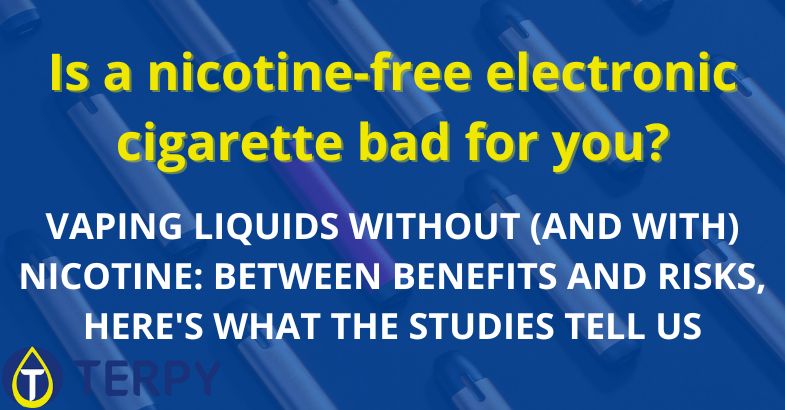Published on: 28/01/2024
VAPING LIQUIDS WITHOUT (AND WITH) NICOTINE: BETWEEN BENEFITS AND RISKS, HERE’S WHAT THE STUDIES TELL US
In a world increasingly attentive to health and well-being, e-cigarettes have become an increasingly central topic of discussion.
In particular, the choice to opt for nicotine-free liquids seems to many to be a further step towards a healthier lifestyle.
Is this an actually true belief, or just a baseless illusion?
In this article, we’ll dive into analyzing the effects of e-cigs (both with and without nicotine), exploring both the possible benefits and potential risks. Through a detailed overview, we will try to understand whether this option is really the best way for those trying to reduce the harm related to smoking.What do e-cigarette liquids contain?
E-cigs emit vapor by heating a special liquid which is then vaporized and inhaled by the user. The main ingredients of these e-liquids are:
- propylene glycol , a liquid that has proven to be absolutely safe when ingested. In fact, it is sometimes also used as a food additive. Regarding its inhalation, it is assumed that it is equally safe for health, but scientific research has not yet obtained overwhelming and definitive evidence in this sense;
- vegetable glycerin , a substance for which exactly the same considerations as those made previously for propylene glycol apply;
- sometimes, water in small quantities;
- concentrated flavours ;
- liquid nicotine , having the same effects as that contained in tobacco.
The latter may also be absent in e-cigarette liquids , but this is a rare occurrence as most vapers vape as an alternative to smoking cigarettes and, therefore, consume liquids containing nicotine.
Read also: How to choose the resistance of the electronic cigarette


Is the absence of nicotine in e-liquids a good thing or a bad thing?
Now, the absence of this substance can constitute a determining factor in reducing health risks because nicotine, once introduced into the body, exerts various effects .
First, it acts as a stimulant on the central nervous system , releasing neurotransmitters such as dopamine, which is associated with feelings of pleasure and satisfaction. This dynamic can create a feeling of euphoria or a temporary boost in energy.
However, as is known, constant use of nicotine can lead to the development of tolerance, forcing the individual to consume increasingly larger quantities to achieve the same effect. Beyond addiction, nicotine also causes an increase in heart rate, blood pressure and can reduce appetite. In the long term, chronic exposure to this substance can lead to cardiovascular problems .
So, if we go back to the opening question of the article, that is, whether vaping without nicotine is bad for you, we can actually say that it is safer than using liquids containing this substance. But, if this were the case, why then are electronic cigarettes often considered healthier alternatives to traditional ones ?
Let’s see it together in the next paragraph.
Electronic cigarettes are healthier than traditional ones: the reason lies in the absence of combustion
When comparing traditional and electronic cigarettes, there is a fact to highlight that many people ignore: the cause of the harmfulness of cigarettes, which cause tens of thousands of deaths every year in the UK, is not the nicotine itself, but the numerous toxic substances and carcinogens generated by the combustion of tobacco .
And the advantage of the electronic cigarette is that it works without any combustion .
Consequently, although most e-liquids contain nicotine, like normal cigarettes, vaping is a much less harmful habit than smoking .
For the moment, this is stated by the scientific research carried out on the subject, stimulated by the debate created around the spread of e-cigs.
The goal of many of these studies is to determine the long-term health effects of e-cigarette use, as well as compare the risks of e-cigarettes with those of tobacco use .
This research analyzes the composition of the vapor produced by vaping devices, evaluating the presence of potentially harmful chemical substances. They also focus on the human body, monitoring aspects such as lung function, cardiovascular health and potential withdrawal symptoms.
IEO research that demonstrated the potential of vaping to quit smoking
One of the most relevant studies in this field was performed by the European Institute of Oncology (IEO), approved both by EMEA (European Medicine Agency) and by the American Testing Authority.
We would like to point out that this was the starting point regarding in-depth studies on e-cigarettes as a method to definitively abandon tobacco cigarettes. He did not aim in any way to promote the electronic cigarette but focused on its benefits for smokers; the e-cig is in fact not recommended for non-smokers but absolutely recommended for those who smoke cigarettes .
Having said that, let’s talk about the pilot study, which involved three scientific hospitalization and treatment institutes in Milan, namely the IEO, the Monzino Cardiology Center and the San Raffaele Hospital. The research focused on approximately 70 patients who had smoked for at least 10 years and had recently been diagnosed with cancer or had suffered an acute myocardial infarction.
The objective of the study was to get patients to abandon tobacco cigarettes. 36 of them were followed only by dedicated medical personnel, with whom 20 to 25% success is usually achieved, while the others also had at their disposal (in addition to counseling) an electronic cigarette with nicotine-free liquids.
The results? After 6 months, 60% of the patients who also had e-cigarettes stopped smoking ; of the 36 patients followed without e-cigarettes, only 32% managed to quit smoking. The period of abstinence was not only based on trust, but was documented by measuring carbon monoxide, which detected any relapses of the smoker.
If you want to learn more, here is the video in which doctors Veronesi and Cipolla describe the results of the study .


Are there any risks associated with other e-liquid ingredients?
While going nicotine-free may seem like a healthier choice, it’s essential to remember that e-liquids (such as tobacco e-liquids) still contain chemicals.
As previously mentioned, propylene glycol and vegetable glycerin are generally considered safe for ingestion, but there is no conclusive research regarding their safety when inhaled as vapor . Furthermore, the flavorings used can vary widely in their composition and in some cases may contain potentially harmful substances.
The main concerns are the flavors and other additives present in the liquid. Some of these, for example, can cause irritation of the respiratory tract or allergic reactions. Additionally, there is concern about long-term exposure to these chemicals and potential health effects, especially considering that e-cigarette use is a relatively recent phenomenon and long-term studies are still ongoing.
Fortunately, there is legislation that manufacturers of e-cigarettes, liquids and related products must comply with, so as to protect the health of consumers and monitor the products placed on the market. Therefore, it is sufficient to choose trusted shops that only sell certified and quality products , such as our Terpy , to protect yourself from similar risks.
In conclusion, and borrowing the words of the Airc, ” Overall, despite the need for further studies, there is now broad consensus on the fact that compared to the traditional consumption of tobacco products, electronic cigarettes ensure a significant reduction in harm for the smoker and for those who live next to him .”
Read also: Smoking and electronic cigarette ban: a look at the Italian legislation
In conclusion
As we have seen previously, to answer in two words the question “Is the electronic cigarette without nicotine bad for you?”, we can state that it has nothing different from e-cigs with liquids with nicotine, indeed, the absence of this substance makes so that the risk for vapers is reduced.
It is undeniable that e-cigarettes , both with and without nicotine, reduce exposure to many of the harmful substances found in combustible tobacco. However, as we have seen, this does not mean that they are totally risk-free. And, above all, it must not be an incentive to use them for those who do not smoke .
They must always be considered only as an effective alternative to traditional cigarettes, a tool to free oneself once and for all from the slavery of nicotine. All with a view to ceasing their use once this objective has been achieved .
After all, that’s exactly why they were invented . And it would be an insult to the history of this device to use it even if there is no need for help in the fight against smoking.
Take Aways
- Composition of e-liquids: E-liquids for electronic cigarettes contain propylene glycol, vegetable glycerin, sometimes water and, often, liquid nicotine. The latter may be absent, but most vapers prefer nicotinized liquids.
- Nicotine Free and Risk Reduced: Avoiding nicotine in e-liquids can reduce the health risks associated with this substance. Nicotine is addictive, affects the central nervous system, and can cause adverse effects such as increased heart rate and blood pressure.
- E-cigarettes vs. Traditional: Electronic cigarettes, although most contain nicotine, are less harmful than traditional cigarettes because they do not involve the combustion of tobacco, the main cause of the toxic and carcinogenic substances present in normal cigarettes.
- Scientific research and benefits of vaping: Scientific studies focus on the potential long-term effects of e-cigarettes on health, comparing them with those linked to tobacco. Research such as that from the European Institute of Oncology (IEO) shows that e-cigs can help smokers quit more effectively than traditional means.
- Risks associated with ingredients: Despite the absence of nicotine, e-liquids still contain chemicals. The flavorings and additives used may cause respiratory irritation or allergic reactions. It is necessary to consider that inhaling these chemicals does not yet have definitive evidence on its long-term safety.
Questions and answers
What do e-cigarette liquids contain?
E-cigarettes emit vapor by heating a specific liquid. The main ingredients of these liquids, known as e-liquids, are propylene glycol, vegetable glycerin, sometimes water and liquid nicotine. The latter can be present in e-cigarette liquids, but there are also nicotine-free variants.
What are the benefits of electronic cigarettes compared to traditional ones?
Electronic cigarettes are considered healthier than traditional ones because they do not generate combustion. This means they do not produce the toxic and carcinogenic substances associated with burning tobacco. Although many e-liquids contain nicotine, vaping is generally less harmful than smoking cigarettes.
What are the risks associated with other e-liquid ingredients?
Nicotine-free e-liquids may seem like a safer choice, but it’s important to remember that they still contain chemicals. While propylene glycol and vegetable glycerin are considered safe for ingestion, their inhaled safety is still being researched. Flavors and additives may vary in composition and some may cause irritation or allergic reactions. Current legislation monitors products to ensure consumer safety.










